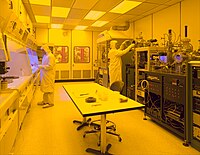
Photo from wikipedia
Conventionally, P–N junctions have played an important role as a key unit in most semiconductor electronic devices. P–N junctions based on organic semiconductors have also been researched widely, but it… Click to show full abstract
Conventionally, P–N junctions have played an important role as a key unit in most semiconductor electronic devices. P–N junctions based on organic semiconductors have also been researched widely, but it is difficult to develop solution-processing-based organic semiconductor P–N junctions because of their similar solubility in common organic solvents. For this reason, most organic planar heterojunctions have been based on deposition by thermal evaporation or transfer film via additional complicated processing. In this study, using p-type and n-type conjugated polymers with selection of their orthogonal solvents, a conjugated polymer bilayer P–N heterojunction structure is developed via simple solution processing. The developed structure is then used in novel organic electronic applications, such as organic rectifier diodes, organic field-effect transistors with highly balanced ambipolar charge transport properties, integrated circuits, and even organic phototransistors that display a photoresponse from the visible to the near-infrared (NIR) range with the generation of a photocurrent at the P–N heterointerface in the channel region. The polymeric P–N junction structure can be applied in various organic electronic devices via a simple printing process, which can contribute to the development of new functionalized organic electronics systems.
Journal Title: Advanced Optical Materials
Year Published: 2017
Link to full text (if available)
Share on Social Media: Sign Up to like & get
recommendations!